Application of the Revegetation Sheet with the Erosion Control Function to the Expansive Clay Soil Slope -A Case Study on Test Construction and Monitoring in West Java, Indonesia-
on
ORIGINAL RESEARCH ARTICLE
Application of the Revegetation Sheet with the Erosion Control Function to the Expansive Clay Soil Slope
Nobuyuki Kohno1* and Takashi Shimizutani1
1 Takino Filter Inc., 904-16, Hayama 2-chome, Kudamatsu-shi, Yamaguchi 744-0061
Japan
*Corresponding author: kouno@takino.co.jp Received : 29th June 2016 | Accepted : 30th August 2016
ABSTRACT
A new type of revegetation sheet which also has a function of soil erosion control was applied to the expansive clay soil slope in West Java, Indonesia, and the function of the sheet to reduce the collapse of the slope was examined. Firstly, it was identified that the soil in the test construction site was a typical expansive clay soil mainly consisting of smectite and quartz according to the X-ray diffraction analysis. Secondly, as a result of monitoring up to 13 months after the application of the sheet, it was observed that the sheet successfully controlled soil erosion and led to gradual vegetation recovery, despite the fact that the construction area is in a part of tropical monsoon climate where the rainy and the dry seasons come repeatedly in a year and the soil swells in rainy season and shrinks and forms crack in dry season. Therefore, it was indicated that as the recovery of vegetation went by, the effect of controlling soil erosion, land slide and slope collapse would be increased.
Keywords : erosion control, revegetation sheet, clay soil slope
INTRODUCTION
In order to prevent the cut and fill slopes made by the road construction etc. from causing the soil erosion and the landslide by heavy rain, a newly developed revegetation sheet, which makes the rainwater drain
out effectively and realizes the revegetation in parallel, has been spotlighted and successfully applied to a variety of fields in Japan for the last two decades1). The new type sheet consists of two materials, i.e.; the polyester non-woven fabric with the
ISSN ONLINE: 9 772303 337 008
porosity of 97 to 98% and the polyethylene net for protection, and allows the reached rainwater to drain out smoothly through the non-woven fabric while the fine fibers of nonwoven fabric grab the soil surface tightly. Because of its structure, the sheet prevents the soil erosion. The new type sheet also allows the germinated plant beneath of the sheet to penetrate the porosity rich fabric to realize the revegetation successfully (Yamamoto and Marumoto, 2012)
The extraordinary weather in present days due to the climate change causes heavy rain which often brings a great disaster such as a large-scale slope collapse and a debris flow in Japan. With regard to the function of the new type sheet for erosion control, it has been demonstrated that it smoothly drains out the rainwater even under the condition of precipitation amount of 100mm/hr and suppresses the rainwater infiltration into soil and is applicable to the preventive measure against causing the debris flow under the condition according to the large scale experiment (Matsumoto et al., 2016).
Because of its high performance for soil erosion control as well as
revegetation, the new type sheet has been further tested or applied to demonstrate the applicability of the sheet under other particular conditions in foreign countries, such as the mud stone in Taiwan (Chuang, 1993), the scoria soil in Bali, Indonesia (Kayo et al., 2015), and the vulnerable sand stone mixed with the gravel in Kingdom of Bhutan (Iwasa, 2017), and it is being ascertained that the new type sheet is effective to controlling the soil erosion and recovering the vegetation in the countries or the regions where the landslide disaster is a serious problem.
Next, a new challenge that is application of the new type sheet to the expansive clay soil slope was planned. The expansive clay soil generally contains a lot of clay minerals such as smectite etc. and it swells and shrinks depending on the water content in soil and then the volume changes largely. According to Soil Taxonomy by Department of Agriculture, United States (USDA), the soil is categorized into Vertisol (Soil Taxonomy, 1999). Vertisol, which is an expansive clay soil, occupies 2.4% of the ice-free area and are distributed in the world including
Indonesia. According to Global Soil Regions in Soil Taxonomy, the expansive clay soil can be found in Java, Timor, Lombok, Sumbawa, Sumba and Flores islands in Indonesia. In Java Island, the soil is distributed in many areas of East Java and in relatively many areas in Central Java and West Java. In West Java, the soil is specifically distributed in the areas of Padalarang, Plered, Cikampek, Cikarang, Karawang and Bukit Indah City. As the shear stress of the soil in these areas is high even under the natural soil water content, the cut slope stands firmly just after cutting, however it starts to fail as a certain time goes by (Raharjo, 2014). Moreover, this type of soil also affects the soil bearing capacity and causes the slope instability and the damage to buildings, roads and the other infrastructures (Raharjo, 2014; Zakaria et al., 2014).
Now, Japanese industrial estates such as MM2100, GIIC, KIIC etc. have been developed in West Java and those are facing at a serious problem of swelling soil and causing numerous cracks. However, an effective method which fulfills both the cost and the effect has not been found.
Since the new type sheet has both functions of controlling the soil erosion and revegetation, examining the application of the sheet to such expansive clay soil slope is valuable. Therefore, in the areas where the soil makes the ground unstable, the application of the new type sheet was examined in terms of the effect of draining out rainwater and preventing the soil from swelling and cracking through more than a year long monitoring on four test sites.
MATERIALS AND METHODS
Soil analysis
On 20th, February, 2014, two soil samples were taken from the upper and the lower sites in A site inside GIIC in Cikarang, Bekasi, West Java, Indonesia and the soil were analyzed to investigate some characteristics of the soil. pH(H2O) and EC for two soil samples, soil particle size, soil particle density, liquid limit, plastic limit and clay mineral composition for one soil sample in the lower site were analyzed. pH(H2O) was analyzed with pH meter (HORIBA, Ltd., F-52) after the supernatants were extracted with de-ionized water at the ratio of 2.5 times more than dry soil weight. EC
ISSN ONLINE: 9 772303 337 008
was analyzed with EC meter (DKK-TOA CORPORATION, CM-30G) after the supernatants were extracted with de-ionized water at the ratio of 5 times more than dry soil weight. Soil particle size, soil particle density and both liquid limit and plastic limit were analyzed by JIS A 1204, JIS A 1202 and JIS A 1205 respectively. Clay mineral composition was analyzed by means of both the whole rock approach and the clay fraction approach using X-ray powder diffraction.
Outline of test constructions and the investigation way
From February, 2014 to January, 2015, the sheets (Takino Filter sheet SP-60 by Takino Filter Inc.) were covered on the developed cut slopes in GIIC, West Java, Indonesia (Table 1). In the test constructions, the sheets with the non-woven fabric made of
Acryl for A site and Polyester for all sites except A site were used respectively.
On 10th, March, 2015, the soil erosion control and vegetation conditions were investigated by the visual observation in both the sheet plot and the neighbor bare plot. Some level differences in the border line between the sheet covered plot and the neighbor bare plot at several points were measured with the measuring tape to evaluate the soil erosion control effect quantitatively by the sheet. In the C site, just after the construction on 5th, December, 2014, the level differences in three points of upper, middle and lower each part inside two quadrats of 1 meter square set up to divide into equal parts of the sheet and another similar sheet were measured.
Table 1. Outline of test construction sites in GIIC, West Java, Indonesia
|
Site |
Construction date |
2 Area (m2) |
Slope gradient(Degree) |
Slope direction |
|
A |
20th, February, 2014 |
50 |
34 |
South east |
|
B |
20th, February, 2014 |
50 |
27 |
North west |
|
C |
5th, December, 2014 |
190 |
10~22 |
South east |
|
D |
14th, January, 2015 |
300 |
25 |
South west |

(a) Full view from the front lower part just after construction (b) Full view from
the front upper part just after construction
Figure 1. Construction condition at A site (Acryl type sheet: 50m2, 20th,
February, 2014)
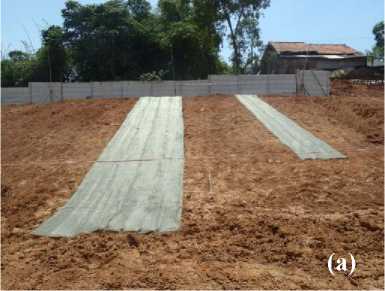
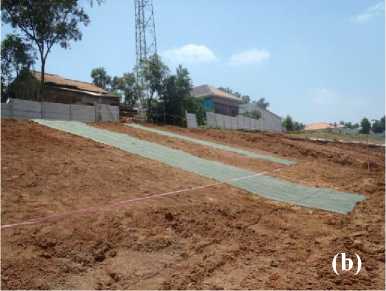
-
(a) Full view from the front lower part just after construction (b) Full view from the
left slant lower part just after construction
Figure 2. Construction condition at B site (Polyester type sheet: 50m2, 20th,
February, 2014)
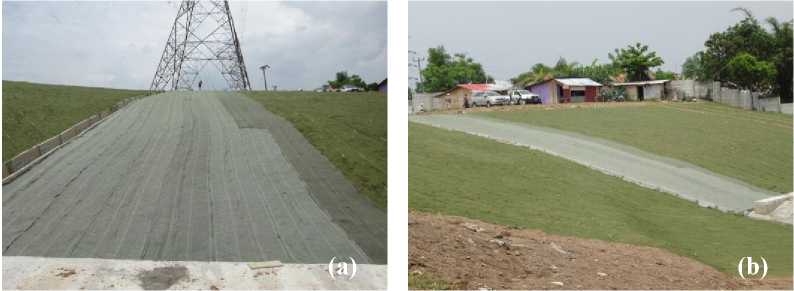
(a) Full view from the front lower part just after construction (b) Full view from the
left slant part just after construction
Figure 3. Construction condition at C site (Polyester type sheet: 190m2, 5th,
December, 2014)
ISSN ONLINE: 9 772303 337 008
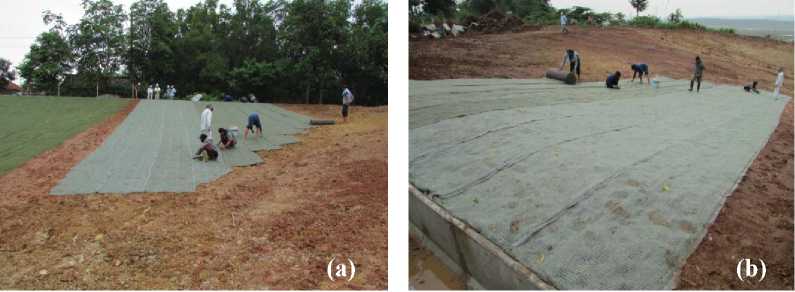
(a) Full view from the front lower part under construction (b) Full view from the front upper part under construction
Figure 4. Construction condition at D site (Polyester type sheet: 300m2, 14th, January, 2015)
RESULTS AND DISCUSSIONS Characteristics of the field soil in the test construction
pH in the upper and the lower parts of the slope in A site were slightly alkaline of 7.6 and strong acid of 4.2 respectively and it varied extensively even in the same site. EC in the upper and the lower parts of the slope in A site were a little low of 0.2dS/m and a little high of 1.1dS/m respectively and it varied as well as pH. Concerning the soil particle size in the lower part of the slope in A site, the silt fraction was the most of 57.8%, and the clay fraction was the
second most of 28.5%, so that the fine particle fraction under 75μm was 86.3%. While, the sand and the gravel fractions were 13.0% and 0.7% respectively, so that the coarse particle fraction was less and the soil was categorized into fine particle clay soil. While, the plasticity index was 93.36 and it was indicated that the soil has high viscosity. According to the plasticity chart which shows the relationship between the plasticity index and the liquid limit, the soil was categorized into the clay soil with high liquid limit (Table 2).
Table 2. Geotechnological properties of the soil in the lower part of the slope in A site
|
Soil particle |
Liquid limit WL |
Plastic limit WP |
Plasticity index |
|
density (g/cm3) |
(%) |
(%) |
Ip |
|
2.764 |
125.03 |
31.68 |
93.36 |
Strength of diffraction
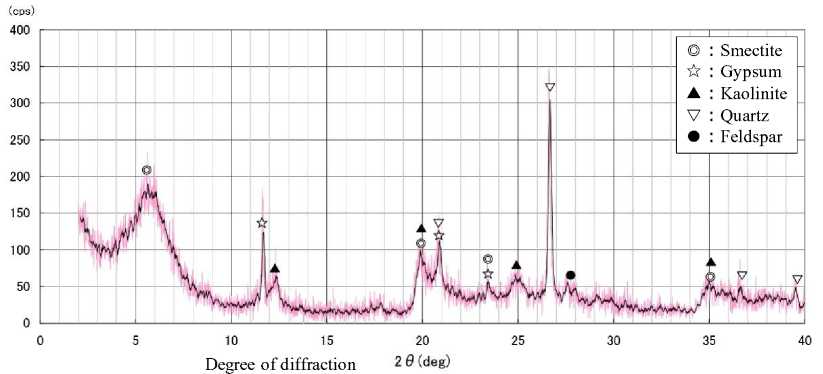
Figure 5. Whole rock approach of the soil in the lower part of the slope in A site using X-ray powder diffraction
By the whole rock approach using the X-ray diffraction, a large amount of smectite and quartz , a small amount of gypsum and a very small amount of feldspar and kaolinite were detected respectively (Figure 5.). While, by the clay fraction approach, kaolinite, smectite and illite were detected and especially the peak of smectite was significantly high (data not shown). In the site near GIIC, smectite, quartz and kaolinite were detected as a result of the whole rock approach using X-ray diffraction (Kumitsu and Katakami, 2013). The result indicated the similar one this time, so that it was considered that the soil has a large amount of smectite and quartz and a small amount of qypsum, feldspar and kaolinite. Actually, the
author observed many big crystals of several centimeters like quartz. From the result of soil analysis, it was indicated that the soil in A site is the typical expansive clay soil
Conditions of the soil erosion control and the vegetation after the construction of the sheet
After 13 months, the disappearance of the protection net by the partial deterioration and the trample of cow in some parts were observed, but the fine fibers of nonwoven fabric adhered to the soil surface firmly. Although the bare soil, on which the sheet had not been covered, in both sides of the sheet was eroded considerably (Figure 6 and 7),
ISSN ONLINE: 9 772303 337 008
the traces of soil erosion beneath the sheet were not observed, so that it was demonstrated that the sheet had prevented the soil erosion remarkably. After 2 months, the level difference in the border line between the sheet covered plot and the neighbor bare plot had been 5 to 10cm, but it increased to 18cm at most after 13
months.
According to the weather data in Bekasi, West Java, Indonesia, total precipitation for 13 months from February, 2014 to March, 2015 was 2,861mm and the temperature was 27 to 35 degrees Celsius and the average temperature was 31.9 degrees Celsius10
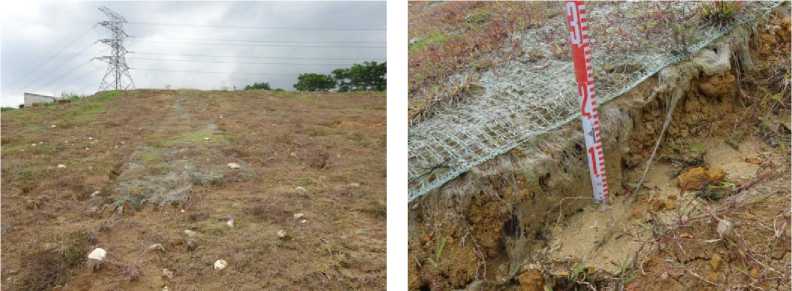
Figure 7. Level difference in the border line between the sheet
Figure 6. Whole view after 13 months
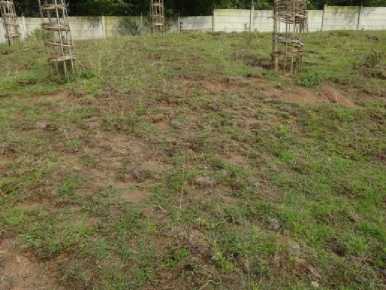
Figure 8. Whole view from the front after 13 months
covered plot and the neighbor bare plot after 13 months
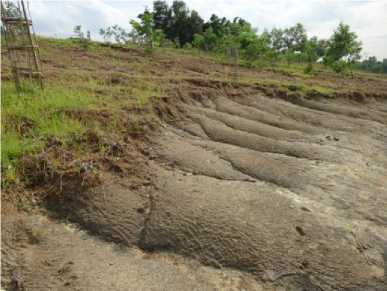
Figure 9. Appearance of the gully erosion occurred in the bare plot of the surrounding of the site
In the site, the sodding was applied after covering with the sheet. Therefore, the sheet was not observed and the only vegetation remained (Figure 8). While, in the bare plot of the surrounding of the site, much gully erosion occurred (Figure 9).
After 3 months, the sheet prevented the soil erosion for the rainfall in rainy season on the whole (Figure 10). In the border line between the sheet covered plot and another similar sheet covered plot, the level difference of 4cm at most was observed (Figure 11). Average level difference values of three points inside the quadrat in the upper and the lower parts of the slope were 1.7cm and 2.3cm respectively, thus the latter was slightly higher than the former. The
step trace which man had walked on the sheet and only one part of erosion trace on the surface soil beneath the sheet were also seen, but the sheet had not been damaged and adhered to the surface soil firmly. From the condition, it was expected that the sheet keeps to prevent the soil erosion continuously afterward.
In another similar sheet covered plot, the sheet and many bamboo skewers were run off by the rainfall and the soil was bared, so that the numerous traces of soil erosion by the raindrop impact were observed. The runoff of soil into the drainage channel under the new type sheet covered plot scarcely occurred (Figure 12), but under another similar sheet covered plot, the soil was run off by rainfall and accumulated in the drainage channel (Figure13).
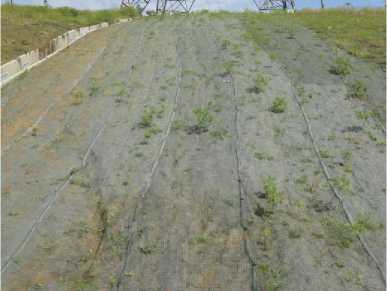
Figure 10. Whole view from the
front after 3 months
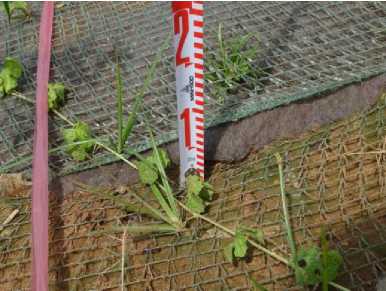
Figure 11. Level difference in the border line between the sheet plot and another similar sheet plot after 3 months
ISSN ONLINE: 9 772303 337 008
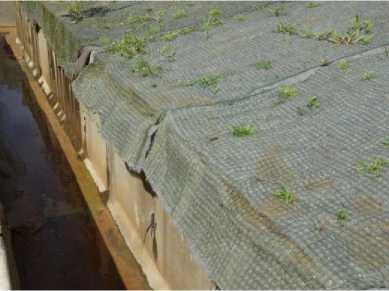
Figure 12. Condition in the drainage
channel under the sheet covered plot
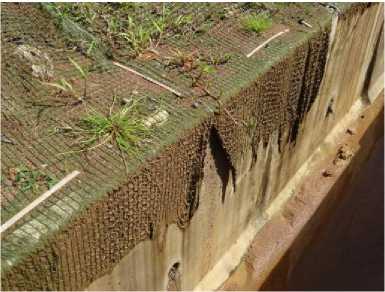
Figure 13. Condition in the drainage channel under another similar sheet
after 3 months
covered plot after 3 months
In the new type sheet covered plot, the vegetation recovered (Figure 14 and 15) and the vegetation rates in the upper and the lower parts were 10% and 5% respectively. While, in another similar sheet covered plot, the vegetation rates in the upper and the lower parts were 30% and 5% respectively. It was considered that the recovery of vegetation had delayed in the new type sheet covered plot because it was covered after another similar sheet had been removed and the slope had been prepared again.
According to the weather data in Bekasi, West Java, Indonesia, total precipitation for 3 months from December, 2014 to February, 2015 was 936mm and the temperature was 28 to 34 degrees Celsius and the average
temperature was 31.3 degrees Celsius (https://ja.worldweatheronline.com/bek asi-weather-averages/west-java/id.aspx).
-
4) D site
After two months, the sheet prevented the soil erosion for rainfall in rainy season on the whole (Figure 16). The conspicuous damage of the sheet and the gully erosion in soil beneath the new type sheet were not seen. While, in the bare part where the sheet had not been covered, the soil surface was run off and many gully erosions occurred (Figure 16). Level differences in the border line between the new type sheet covered plot and the neighbor bare plot in the upper and lower parts of slope were 6.0cm and 11.0cm respectively, so that the latter was
bigger than the former because the latter was steeper than the former (Figure 18). In another similar sheet covered plot, the non-woven fabric and many bamboo skewers were run off
and the soil surface was bared and the soil which had been run off by rainfall was accumulated in the under part of slope as well as in C site (Figure 19).
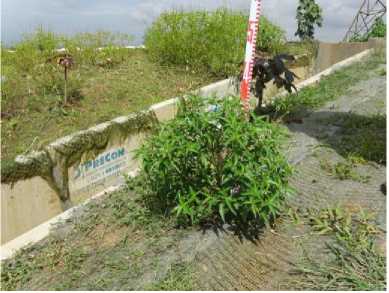
Figure 14. Condition of vegetation in the sheet covered plot after 3 months
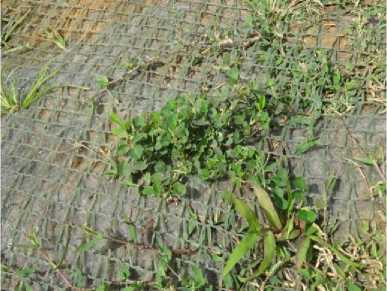
Figure 15. Condition of the growth of creeping plants in the sheet covered plot after 3 months
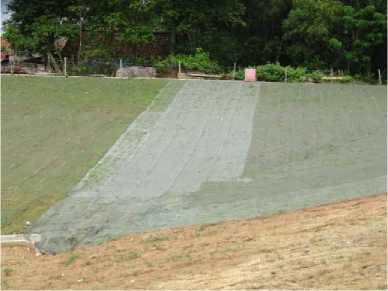
Figure 16. Whole view after 2 months
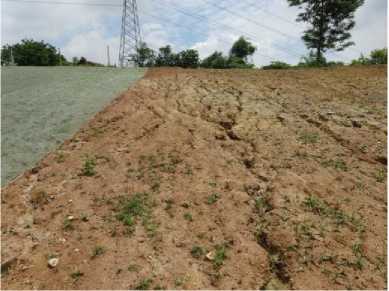
Figure 17. Appearance of the gully erosion occurred in the bare part of the neighbor of the sheet covered plot
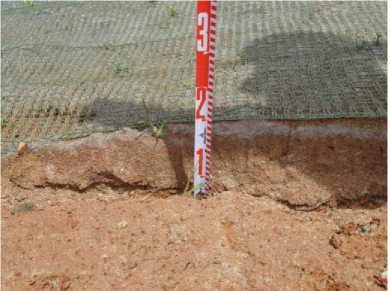
Figure 18. Level difference in the border line between the sheet covered plot and the neighbor bare plot after 2 months
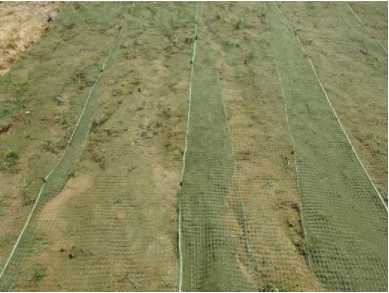
Figure 19. Appearance of soil erosion beneath another similar sheet after 2 months
ISSN ONLINE: 9 772303 337 008
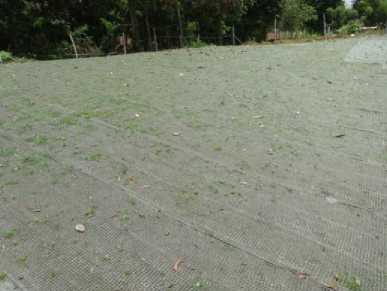
Figure 20. Distant view of vegetation in the sheet covered plot after 2 months
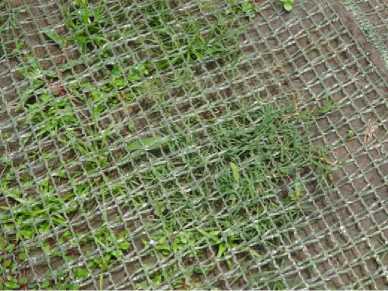
Figure 21. Close-range view of vegetation in the sheet covered plot after 2 months
In the bare plot, the vegetation rate was 10%, but the vegetation rates in the upper and the lower parts of slope covered with both the new type sheet and another similar sheet were 20% and 5% respectively (Figure 20 and 21). From the result, it was considered that the invading plants of the flied and buried seeds had established and grown easily in the upper part of slope.
According to the weather data in Bekasi, West Java, Indonesia, total precipitation for 2 months from January, 2015 to February, 2015 was 536mm and the temperature was 28 to 33 degrees Celsius and the average temperature was 31.0 degrees Celsius10).
ACKNOWLEDGEMENT
Since this paper was developed by summarizing data from the activities during “the Pilot Survey for Disseminating SME’s Technology for Disaster Prevention and Environmental Regeneration” (from 2013 to 2015) sponsored by Japan International Cooperation Agency (JICA), we would firstly like to express our gratitude to JICA staff for the opportunity. Furthermore, we would like to thank Mr. Masatomo Matsubara & Mr. Isao Mori from Nippon Koei Co., Ltd., Mr. Naoki Wakamatsu & Mr. Nobushige Kineri from PT. Puradelta Lestari, for the execution of test constructions and monitoring, and Dr. Shunji Ue, Mr. Yasushi Fukuda from Tokuyama
College of Technology & Dr.
Yoshifumi Kochi from K’s Lab
Corporation for the soil analysis.
References
Yamamoto, K. and Marumoto, T.
(2012) With the aim of environmental regeneration. RESOURCES PROCESSING, Vol.59, No.4, 168-173 (in
Japanese)
Matsumoto, A., Yoshifumi Kochi and Masayuki Hyodo (2016) Rainfall experiments with fullsize model that reproduces the debris flow source head. Proceedings of 8th Symposium on the landslide disaster, 211216 (in Japanese)
Chuang, C. (1993) The Influence of Mulching Materials on Vegetation Growth and Soil Erosion, In Sen-Hsiung Hsu and Chia-Chun Wu (ed.) SINO-JAPANESE SYMPOSIUM ON APPLICATION OF
MULCHING MATERIALS
FOR SOIL AND WATER CONSERVATION, 1-19 (in
Chinese)
Gouya, K., Suzuki, M., and Yamamoto, K. (2015) The Prevention of Soil Erosion and the Revegetation in the Volcanic devastated land of Mt. Batur, Proceedings of 67th Research Meeting by Chugoku Regional Branch Office in Japan Society of Civil Engineers, 471-472 (in
Japanese)
Iwasa, N. (2017) Challenge for slope stability method of Bhutan with NONFRAME Method, Journal of the Japan Society of Erosion Control Engineering, Vol.69, No.5, 66-70 (in
Japanese)
Soil Taxonomy (1999) A Basic System of Soil Classification for Making and Interpreting Soil Surveys, 2nd Edition, Eds. Soil Survey Staff in USDA
Rahardjo, P. P. (2014) Geotechnical Failures Case Histories of Construction on Soft Soils, Forensic Investigations and Counter Measures in
Indonesia. International
Journal of Integrated
Engineering, Vol.6, No.2, 1123
Zakaria, Z. et al. (2014) Soil Activity and Its Relationship to Decreasing Soil Bearing Capacity at Majalengka, West Java, Indonesia. 1st
International Conference of
Geoscience for Energy,
Mineral Resources, and Environment
Kunitsu, H. and Katakami, N. (2013) Properties of expansive clay in Indonesia. Summaries of technical papers of annual meeting Architectural Institute of Japan in the 2013 fiscal year, 831-832 (in Japanese)
https://ja.worldweatheronline.com/be kasi-weather-averages/west-java/id.aspx
ASIA OCEANIA BIOSCIENCES AND BIOTECHNOLOGY CONSORTIUM • 71
Discussion and feedback